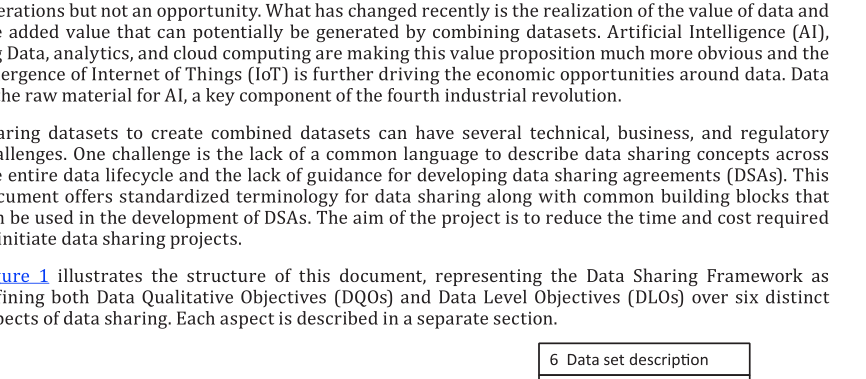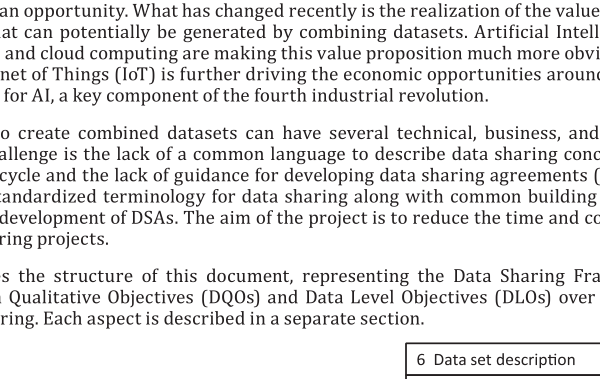ISO IEC 23751:2022 pdf download – Information technology — Cloud computing and distributed platforms — Data sharing agreement (DSA) framework.
1 Scope This document establishes a set of building blocks, i.e. concepts, terms, and definitions, including Data Level Objectives (DLOs) and Data Qualitative Objectives (DQOs), that can be used to create Data Sharing Agreements (DSAs). This document is applicable to DSAs where the data is intended to be processed using one or more cloud services or other distributed platforms. 2 Normative references There are no normative references in this document. 3? Terms? and? definitions For the purposes of this document, the following terms and definitions apply. ISO and IEC maintain terminology databases for use in standardization at the following addresses: — ISO Online browsing platform: available at https:// www .iso .org/ obp — IEC Electropedia: available at https:// www .electropedia .org/ 3.1 party natural person or legal person, whether or not incorporated, or a group of either [SOURCE: ISO/IEC 27729:2012,3.1] 3.2 data originator party (3.1) that created the data and that can have rights Note 1 to entry: A data originator can be an individual person. Note 2 to entry: The data originator can be distinct from the natural or legal person(s) mentioned in, described by, or implicitly or explicitly associated with the data. For example, PII can be collected by a data originator that identifies other individuals. Those data subjects (PII Principals) can also have rights, in relation to the data set. Note 3 to entry: Rights can include the right to publicity, right to display name, right to identity, right to prohibit data use in a way that offends honourable mention. 3.3 data broker party (3.1) that collects data from one or more sources and sells the data to one or more data users (3.5) Note 1 to entry: In the context of data broker, sell means to provide data in exchange for money or other item of value.
3.12 data level objective DLO commitment a data holder (3.4) or a data user (3.5) makes for a specific, quantitative characteristic of a dataset, where the value follows the interval scale or ratio scale (3.11) Note 1 to entry: A data level objective commitment can be expressed as a range. 3.13 data qualitative objective DQO commitment a data holder (3.4) or a data user (3.5) makes for a specific, qualitative characteristic of a dataset, where the value follows the nominal scale or ordinal scale Note 1 to entry: A data qualitative objective can be expressed as an enumerated list. Note 2 to entry: Qualitative characteristics typically require human interpretation. Note 3 to entry: The ordinal scale allows for existence/non-existence. 3.14 public domain data class of data objects over which nobody holds or can hold copyright or other intellectual property Note 1 to entry: Data can be in the public domain in some jurisdictions, while not in others. Note 2 to entry: The concept of public domain and the difference between this and “publicly available” is subtle and varies between jurisdictions. Readers should make themselves aware of the specific legal situation as it can apply to them. [SOURCE: ISO/IEC 19944-1:2020, 3.4.4]
ISO IEC 23751:2022 pdf download – Information technology — Cloud computing and distributed platforms — Data sharing agreement (DSA) framework






